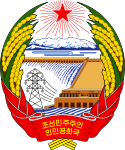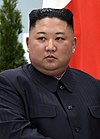General Secretary of the Workers' Party of Korea
| General Secretary of the Workers' Party of Korea | |
|---|---|
| 조선로동당 총비서 | |
Forbidden City | |
| Seat | Pyongyang |
| Nominator | Party Congress |
| Appointer | Party Congress |
| Term length | Five years, life tenure |
| Constituting instrument | Rules of the Workers' Party of Korea |
| Inaugural holder | Kim Tu-bong |
| Formation | 24 June 1949 |
| Deputy | Secretariat |
| General Secretary of the Workers' Party of Korea | |
| Hangul | 조선로동당 총비서 |
|---|---|
| Hanja | |
| Revised Romanization | Joseon Rodongdang Chongbiseo |
| McCune–Reischauer | Chosŏn Rodongdang Ch'ongbisŏ |
 |
|---|
|
|
The General Secretary of the Workers' Party of Korea (
ex officio" Chairman of the WPK Central Military Commission and leads the work of the secretariat.[1] Additionally, the general secretary is by right of office member of the WPK Presidium, the WPK Politburo
and the WPK Secretariat.
The office traces its lineage back to the reestablishment of the
Kim Il Sung as Chairman of the WPK Central Committee.[10]
The offices of Chairman and Vice Chairman of the WPK Central Committee were abolished on 12 October 1966 and replaced with the offices of General Secretary and Secretary of the
Vice Chairman of the WPK Central Committee.[15] A similar change took place at the 8th WPK Congress, where the offices of chairman and vice chairman were abolished and replaced by the office of General Secretary of the Workers' Party of Korea and the Secretariat.[16]
Title history
| Title | Established | Abolished | Established by |
|---|---|---|---|
| Chairman of the Central Committee of the Communist Party of Korea 조선공산당 중앙위원회 위원장 |
14 September 1945 | 10 April 1946 | 1945 Congress of the Communist Party of Korea |
| First Secretary of the North Korean Branch Bureau of the Communist Party of Korea 조선공산당 북조선분국 비서 |
13 October 1945 | 10 April 1946 | Conference of Members and Enthusiasts in the Five Northwestern Provinces |
| First Secretary of the Central Committee of the Communist Party of North Korea 북조선공산당 중앙위원회 위원장 |
10 April 1946 | 30 August 1946 | 5th Enlarged Plenary Session of the North Korean Branch Bureau's Executive Committee |
| Chairman of the Central Committee of the Communist Party of South Korea 남조선공산당 중앙위원회 위원장 |
10 April 1946 | 24 November 1946 | April Plenary Session of the Central Committee of the Communist Party of Korea |
| Chairman of the Central Committee of the Workers' Party of North Korea 북조선로동당 중앙위원회 위원장 |
30 August 1946 | 24 June 1949 | 1st Congress of the Workers' Party of North Korea |
| Chairman of the Central Committee of the Workers' Party of South Korea 남조선로동당 중앙위원회 위원장 |
24 November 1946 | 24 June 1949 | 1st Congress of the Workers' Party of South Korea |
| Chairman of the Central Committee of the Workers' Party of Korea 조선로동당 중앙위원회 위원장 |
24 June 1949 | 12 October 1966 | 1st Joint Plenary Session of the 2nd Central Committee of the Workers' Party of Korea |
| General Secretary of the Central Committee of the Workers' Party of Korea 조선로동당 중앙위원회 총비서 |
12 October 1966 | 8 October 1997 | 14th Plenary Session of the 4th Central Committee of the Workers' Party of Korea |
| General Secretary of the Workers' Party of Korea 조선로동당 총비서 |
8 October 1997 | 11 April 2012 | Joint Communique of the 6th Central Committee and the 6th Central Military Commission |
| First Secretary of the Workers' Party of Korea 조선로동당 제1비서 |
11 April 2012 | 9 May 2016 | 4th Conference of the Workers' Party of Korea |
| Chairman of the Workers' Party of Korea 조선로동당 위원장 |
9 May 2016 | 10 January 2021 | 7th Congress of the Workers' Party of Korea |
| General Secretary of the Workers' Party of Korea 조선로동당 총비서 |
10 January 2021 | Incumbent | 8th Congress of the Workers' Party of Korea |
| References: [11][13][14][15][16][17] | |||
Predecessors (1945–49)
National
| No. [note 2] |
Portrait | Name | Hangul | Took office | Left office | Duration | Birth | Death | Ref. |
|---|---|---|---|---|---|---|---|---|---|
| 1 | 
|
Pak Hon-yong | 박헌영 | 14 September 1945 | 10 April 1946 | 208 days | 1900 | 1955 | [2] |
In the North
| No. [note 2] |
Portrait | Name | Hangul | Took office | Left office | Duration | Birth | Death | Ref. |
|---|---|---|---|---|---|---|---|---|---|
| 1 | 
|
Kim Yong-bom | 김용범 | 13 October 1945 | 18 December 1945 | 66 days | 1902 | 1947 | [18] |
| 2 | 
|
Kim Il Sung
|
김일성 | 18 December 1945 | 30 August 1946 | 255 days | 1912 | 1994 | [19] |
| 3 | 
|
Kim Tu-bong | 김두봉 | 31 August 1946 | 24 June 1949 | 2 years and 297 days | 1889 | 1958 | [20] |
In the South
| No. [note 2] |
Portrait | Name | Hangul | Took office | Left office | Duration | Birth | Death | Ref. |
|---|---|---|---|---|---|---|---|---|---|
| 1 | 
|
Pak Hon-yong | 박헌영 | 10 April 1946 | 24 November 1946 | 228 days | 1900 | 1955 | [9] |
| 2 | 
|
Ho Hon | 허헌 | 24 November 1946 | 24 June 1949 | 2 years and 212 days | 1885 | 1951 | [9] |
Leaders of the Workers' Party of Korea
By officeholders
| No. [note 2] |
Portrait | Name | Hangul | Took office | Left office | Duration | Birth | Death | Ref. |
|---|---|---|---|---|---|---|---|---|---|
| 1 | 
|
Kim Il Sung
|
김일성 | 24 June 1949 | 8 July 1994 | 45 years and 14 days | 1912 | 1994 | [10] |
| 2 | 
|
Kim Jong Il
|
김정일 | 8 October 1997 | 17 December 2011 | 14 years and 70 days | 1941 | 2011 | [13] |
| 3 | 
|
Kim Jong Un
|
김정은 | 11 April 2012 | Incumbent | 12 years and 4 days | 1983 | —
|
[21] |
By term
| Congress | Term | Start | End | Duration | Leader |
|---|---|---|---|---|---|
| 1st Congress | 1st Central Committee | 30 August 1946 | 30 March 1948 | 1 year and 213 days | Kim Tu-bong |
| 2nd Congress | 2nd Central Committee | 30 March 1948 | 29 April 1956 | 8 years and 30 days | Kim Tu-bong |
Kim Il Sung
| |||||
| 3rd Congress | 3rd Central Committee | 29 April 1956 | 18 September 1961 | 5 years and 142 days | Kim Il Sung
|
| 4th Congress | 4th Central Committee | 18 September 1961 | 13 November 1970 | 9 years and 56 days | Kim Il Sung
|
| 5th Congress | 5th Central Committee | 13 November 1970 | 14 October 1980 | 9 years and 336 days | Kim Il Sung
|
| 6th Congress | 6th Central Committee | 14 October 1980 | 9 May 2016 | 35 years and 208 days | Kim Il Sung
|
Kim Jong Il
| |||||
Kim Jong Un
| |||||
| 7th Congress | 7th Central Committee | 9 May 2016 | 10 January 2021 | 4 years and 246 days | Kim Jong Un
|
| 8th Congress | 8th Central Committee | 10 January 2021 | Incumbent | 3 years and 96 days | Kim Jong Un
|
| References: [10][13][15][16][22][23][24][25][26] | |||||
See also
- Politburo of the Workers' Party of Korea
- Presidium of the Politburo of the Workers' Party of Korea
- Secretariat of the Workers' Party of Korea
Notes
References
Footnotes
- ^ Madden, Michael (2 February 2012). "4th Party Conference To Convene in "mid-April"". North Korea Leadership Watch. Archived from the original on 29 November 2020. Retrieved 12 February 2021.
Madden, Michael. "Party Secretariat". North Korea Leadership Watch. Archived from the original on 20 August 2023. Retrieved 13 February 2021. - ^ a b Suh 1981, p. 281.
- ^ Suh 1981, pp. 279–80.
- ^ Lee 1963, p. 5; Suh 1981, p. 280.
- ^ Suh 1981, p. 280.
- ^ Suh 1981, pp. 282–3.
- ^ Suh 1981, p. 283.
- ^ Suh 1981, p. 282.
- ^ a b c Suh 1981, p. 318.
- ^ a b c Suh 1981, p. 321.
- ^ a b Suh 1981, p. 328.
- ^ Suh 1981, p. 328; Gause 2011, p. 18.
- ^ a b c d e Gause 2011, p. 18.
- ^ a b Gause 2013, pp. 40–41.
- ^ a b c Madden, Michael (20 May 2016). "Deciphering the 7th Party Congress: A Teaser for Greater Change?". 38 North. Archived from the original on 12 February 2021. Retrieved 12 February 2021.
- ^ a b c Frank, Rüdiger (19 January 2021). "Key Results of The Eighth Party Congress in North Korea (Part 2 of 2)". 38 North. Archived from the original on 12 February 2021. Retrieved 12 February 2021.
- ^ Suh 1981, pp. 279–83.
- ^ Suh 1981, pp. 281–82.
- ^ Suh 1981, p. 316.
- ^ Suh 1981, p. 319.
- ^ Sang-Hun, Choe (11 April 2012). "As Rocket Launching Nears, North Korea Continues Shift to New' Supreme Leader'". The New York Times. Retrieved 18 September 2023.
- ^ Suh 1981, pp. 316–17.
- ^ Suh 1981, pp. 319–20.
- ^ Suh 1981, p. 322.
- ^ Suh 1981, p. 325.
- ^ Suh 1981, p. 332.
Bibliography
"Books:"
- Gause, Ken E. (2011). North Korea Under Kim Chong-il: Power, Politics, and Prospects for Change. ISBN 978-0313381751.
- Gause, Ken (2013). "The Role and Influence of the Party Apparatus". In Park, Kyung-ae; Snyder, Scott (eds.). North Korea in Transition: Politics, Economy, and Society. ISBN 978-1442218123.
- Suh, Dae-sook (1981). Korean Communism 1945–1980: A Reference Guide to the Political System (1st ed.). ISBN 0-8248-0740-5.
"Journal articles:"
- Chong-sik Lee (1963). "Politics in North Korea: Pre-Korean War Stage". JSTOR 651339.
